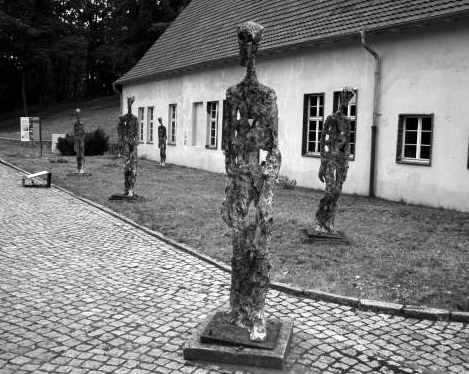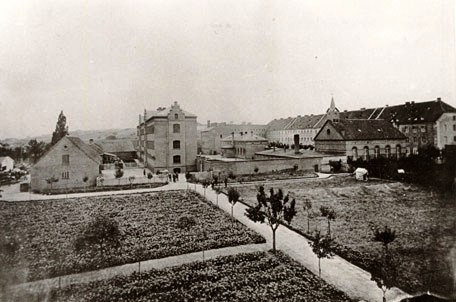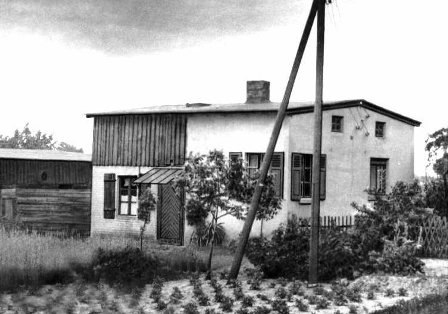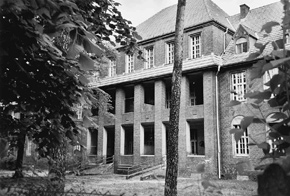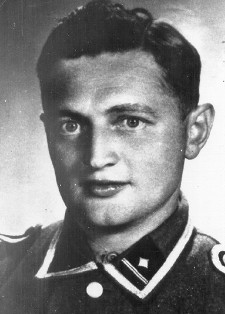Holocaust Education & Archive Research Team |
Euthanasia
Nazi Eugenics & Euthanasia T- 4 Staff T- 4 in Poland T - 4 in Germany & Austria
| ||||
Brandenburg Euthanasia Centre
In 1790, a home for paupers was founded in Brandenburg, near Berlin. In 1820, the complex of buildings was extended and subsequently used as a prison, until in 1932, the prison was closed following the building of a penitentiary in Brandenburg-Görden. From 24 August 1933 until 2 February 1934 the Nazis used the city-centre buildings of the former prison at 90-C Neuendorfer Straße as a concentration camp and police barracks.
Up to 1,200 prisoners were incarcerated in the cells. In 1939 some of the buildings were converted into a euthanasia killing centre named “Brandenburg State Hospital and Nursing Home” (Heil- und Pflegeanstalt Brandenburg).
The site was probably chosen for its convenient location. A gas chamber (3x5 m) was installed in a former brick barn, although the exact location of the gas chamber within the barn is unknown, since only the foundations of the barn remain.
The gas chamber was disguised as a shower room, but at first no showerheads were installed and patients were therefore told that they were entering an "inhalation room" for therapeutic reasons. Later showerheads were added. Only the floor of the adjacent former storage building is now visible. The cells no longer exist; it was not until 1996 that their foundations were uncovered. The killings took place in similar fashion in all of the euthanasia centres: buses brought the victims to the site where they were registered, undressed, examined and gassed. Bodies were cremated at night in two mobile cremation ovens attached to the chimney of the building and heated with oil.
There were seven SS stokers and ten SS guards who sometimes also worked as stokers. Flames often escaped from the chimney, which added to the unpleasant smell of burning flesh, in July 1940 caused the crematory ovens to be moved to an isolated house surrounded by a high wooden fence and located about three miles outside the town at Paterdamm Street. This site was camouflaged as Chemisch-Technische Versuchsanstalt (Chemical and Technical Research Institute); the corpses were driven there in a post office van at night. The first killings took place in December 1939 or January 1940, when 18-20 handicapped patients were gassed in a test which was decisive in arriving at the decision to use carbon monoxide gas as the killing agent for the euthanasia programme.
It is impossible to state with certainty who attended the gassing demonstration, but there is testimony that the following persons were present:
Hitler's two plenipotentiaries for euthanasia, Karl Brandt and Philipp Bouhler, as well as Leonardo Conti, the state secretary for health in the Ministry of the Interior (RMdI). Also in attendance were Herbert Linden from the Ministry of the Interior and the KdF (Führer Chancellery).
The bureaucrats responsible for the implementation of euthanasia:
Viktor Brack, Werner Blankenburg, Hans Hefelmann, Reinhold Vorberg, Richard von Hegener, and Gerhard Bohne. Further, the T4 physicians Werner Heyde, Paul Nitsche, Irmfried Eberl, Horst Schumann, and Ernst Baumhard participated in the demonstration, as well as the KTI (Institute for Criminal Technology) chemists Albert Widmann and August Becker.
Finally, the Stuttgart police officer Christian Wirth, who was to play an essential role in Nazi killing operations, was also present during this first demonstration of systematic mass murder. Watching through a peephole, Becker observed how very quickly “people toppled over, or lay on benches” – all without “scenes or commotions.” Becker noticed that Eberl had opened the gas container too quickly and the escaping gas made a hissing sound. Fearful that this noise "would make the victims uneasy," Becker demonstrated how to open the valve slowly and quietly, and "thereafter the killing of the mental patients progressed without further incidents."
The gas chamber was quickly ventilated, and SS men used special stretchers to mechanically push the corpses into the crematory ovens. Brack and Brandt both expressed their satisfaction with the test. The final killings took place on 29 October 1940. Children from the mental home in Brandenburg-Görden were murdered. A large hospital complex, Brandenburg-Görden had provided the first killing ward for children.
It was situated near Berlin, and rapid communication with the KdF thus posed no problem. Further, Görden was headed by Hans Heinze, who served as one of the three evaluators for children's euthanasia.
The Görden ward and the methods introduced there by Heinze served as the model for other children's wards; Görden became a training centre for physicians assigned to direct the killing of children. In addition, unlike almost all other children's wards, Görden had ample research facilities where Heinze and his students performed medical experiments on the children before and after they were killed.
The T4 electrician, Herbert Kalisch, witnessed the murder of a transport of Jewish patients at Brandenburg in June 1940:
In his 1940 pocket diary, Irmfried Eberl, as physician-in-charge at Brandenburg, noted the arrival of transports for gassing, often listing the number of victims and usually indicating the composition by using the capital letter "M" for men (Männer), "F" for women (Frauen), and "J" for Jews (Juden). The diary contains a relatively large number of "J" entries.
On 27 April 1997 the Brandenburg memorial was dedicated at the site of the euthanasia centre.
Copyright: WAG H.E.A.R.T 2007
|
